General Introduction
Luminescence is the emission of light, and it can occur in many ways. In research and biomedical industry fluorescence and chemiluminescence are often used. Fluorescence is when light is absorbed then emitted by a substance. A photon of a higher energy state is absorbed, then a lower energy photon is emitted in another range of the electromagnetic spectrum.
On the other hand, chemiluminescence (CL) is the conversion of the chemical energy into the emission of visible light as the result of an oxidation or hydrolysis reaction. The CL related reaction is shown as follows:

The luminol reaction is used as an example of CLIA reaction. In the presence of hydrogen peroxide, in basic conditions and with a catalyst, the luminol goes to an excited state and then to a ground state realising light. The reaction is shown as follows:

In an immunoassay assay, CL is used as a label to display the information resulting from an immuno binding reaction. The CL applied to immunoassay is abbreviated as CLIA, and the emission of the light can be induced either in a glow-kinetics or in a flash-kinetics reaction. While the glow-kinetics reaction refers to an indirect method using enzyme labels such as HRP and AP+substrates, the Flash-kinetics reaction is a direct method which makes use of chemiluminescent labels such as luminol derivatives and acridinium. The glow-kinetics is characterized by a slow emission (minutes) of light that remains stable for minutes, while in the flash-kinetics there is a rapid emission of light (tenths of second) that decays in a few seconds being a more convenient method for IVD automated platforms.

Current Applications
Chemiluminescence is used in a wide range of applications such asenvironment monitoring, food analysis, forensic science, western blotting, DNA hybridization and CLIA, among others. For example, researchers monitor the presence of antibiotics in cows or the presence of pesticides in honey bees. Food and water can be tested for lead, antibiotics, or harmful bacteria such as E.coli using CLIA. Other applications in the biomedical field used CLIA to detect autoantibodies. Chemiluminescent immunoassays are also used for haemostasis markers, tumour markers, in clinical applications, Hepatits and infectious diseases detection. In 2020, CLIA was used for the detection of anti-SARS-CoV-2 IgG and IgM in patient samples.
Advantages over other techniques
A major advantage of chemiluminescent immunoassays is the simplicity of the detector needed to record data. Chemiluminescence emits light without the need of excitation from a light source or a detector for a wide range of wavelengths not in the visible spectrum. This is also advantageous because there will be no potential for background from the substance being observed, since the only light emitted will be from the chemiluminescent reaction. Unlike in fluorescent assays where autofluorescence is an issue to monitor. Chemiluminescence also doesn’t require separation of absorption and emission wavelengths to understand the readout, it is more direct.
Related news
- Protein Molarity Calculator
- Magnetic immunoprecipitation (IP) input into western blot analysis
- Monoclonal vs. Polyclonal antibodies





